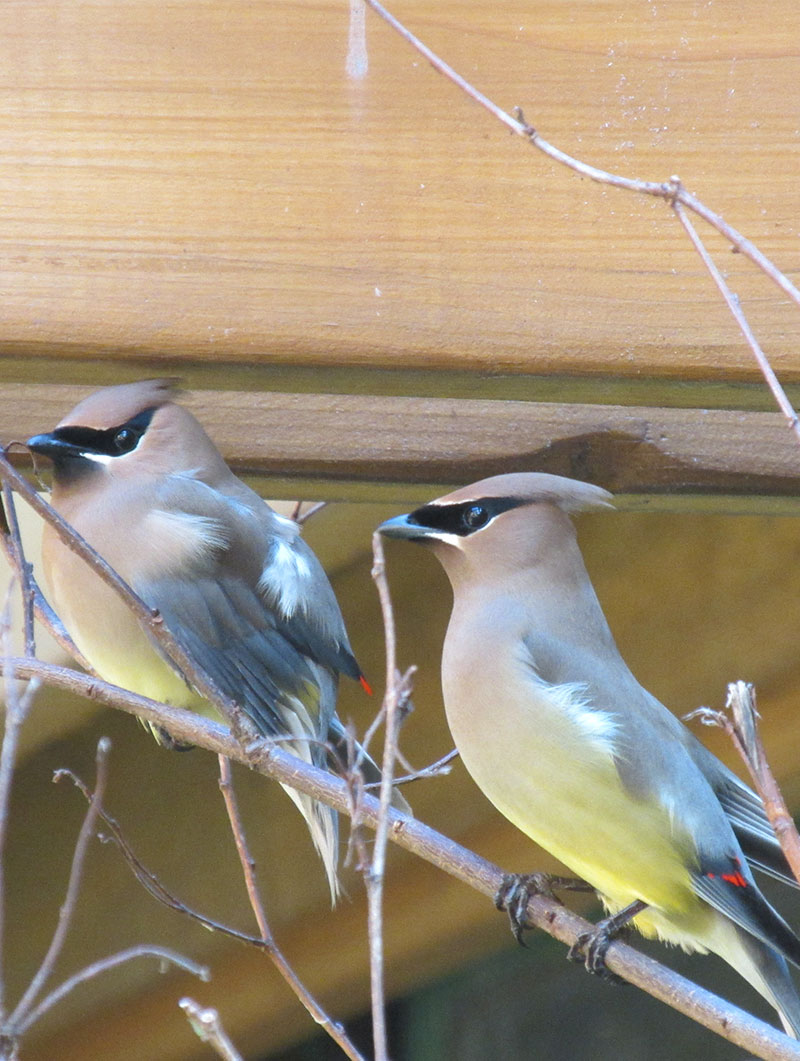Cedar Waxwing
Bombycilla cedrorum
Description:
Cedar Waxwings have gray-brown colored bodies with small groups of bright red waxy deposits at the tips of their wing feathers. The tips of their tails are a bright yellow or orange color. There is a small crest of feathers on top of the head, and a black mask edged with white around the eyes. Males and females are similar in appearance. The belly of an adult is a pale yellow color. Juveniles lack this yellow coloration, have smaller crests atop their heads, and no red wing tips.
Size:
Cedar waxwings measure 6-7 inches (15.2-17.8 cm) in length with a wingspan of 9-12 inches (22.9-30.5 cm). They weigh about 1 ounce (28 g).
Adaptations:
- A cedar waxwing has an unusually large liver, which helps it process all the sugar contained in the fruit it consumes.
- Food moves quickly through a cedar waxwing’s digestive system. This is important because birds can suffer from alcohol intoxication if fermented fruit stays in their bodies for a long period of time.
- Cedar waxwings often form large flocks to search for food. This helps them to find berry patches more efficiently.
Diet:
Cedar waxwings are frugivores (fruit eaters) which consume fruits and berries. In the breeding season, insects become part of their diet as well. At Cosley Zoo, the cedar waxwings’ diet consists of produce, bird seed, and mealworms.
Reproduction:
Cedar waxwings wait until late in the season to nest, often laying their eggs between June and August to take advantage of the plentiful fruits and berries available to feed their young. Cedar waxwings build nests of grass and twigs. Both sexes participate in the building of the nest. The female lays a clutch (group of eggs) of five or six eggs and incubates the eggs for about 12 days before they hatch. Young birds leave the nest
14-18 days after they hatch. Cedar waxwings raise two broods per season, with the second brood being raised immediately after the first.
Shelter and space needs:
Cedar waxwings prefer a wooded edge, where there is a good source of berries as well as water. In the winter, they will move around until they find a food source. Sometimes they will travel to the southern states, but the birds can also be found in the Midwest in the winter if there is a plentiful food supply available.
Life expectancy:
Cedar waxwings can live up to seven years in human care. Their longevity in the wild is uncertain.
Relationship with man:
Cedar waxwings are popular with birdwatchers and play an important role in helping to disperse the seeds of the fruit they eat. They are protected by the US Migratory Bird Act, which makes it illegal to possess these birds or their nests, eggs, or feathers without a permit.
Fun Facts:
- The tip of a cedar waxwing’s tail is bright yellow or orange, depending on its diet. Birds that eat a certain type of honeysuckle berry while they are growing their tail feathers will have orange feather tips.
- During courtship, a male and female bird will sit together passing food items back and forth between their bills.
- If there is a large supply of berries at the end of a twig, a flock of cedar waxwings lines up along a branch and passes berries down the line so that each bird gets some.
- The name “waxwing” comes from the waxy red feathers at the tips of the wings.






